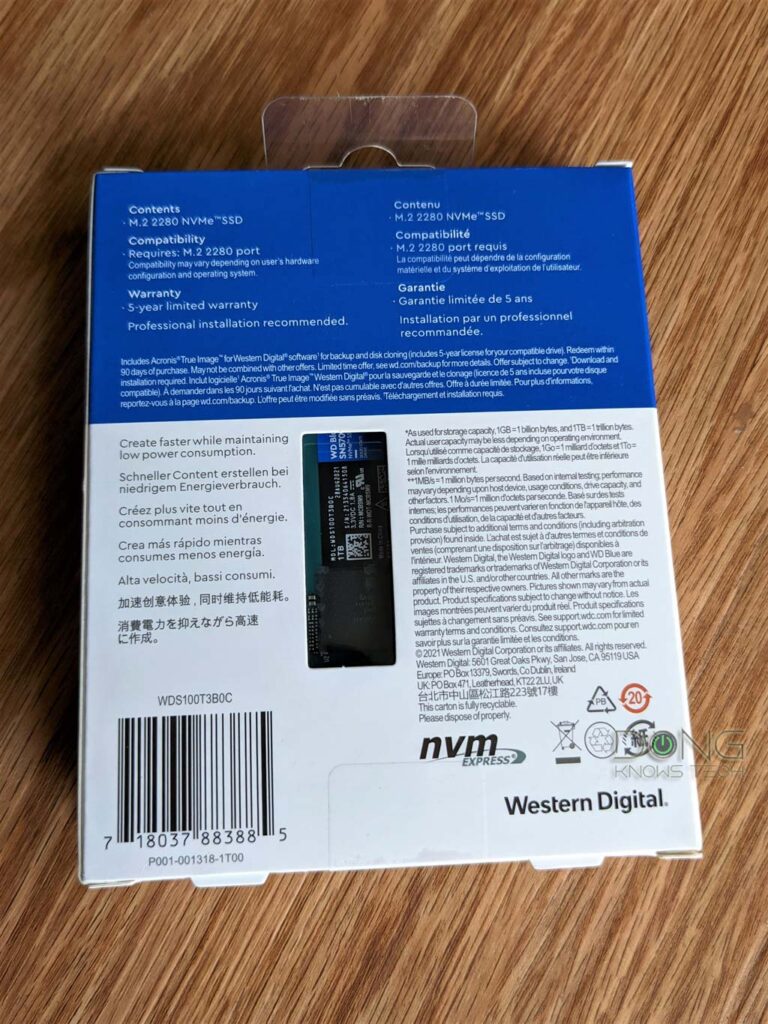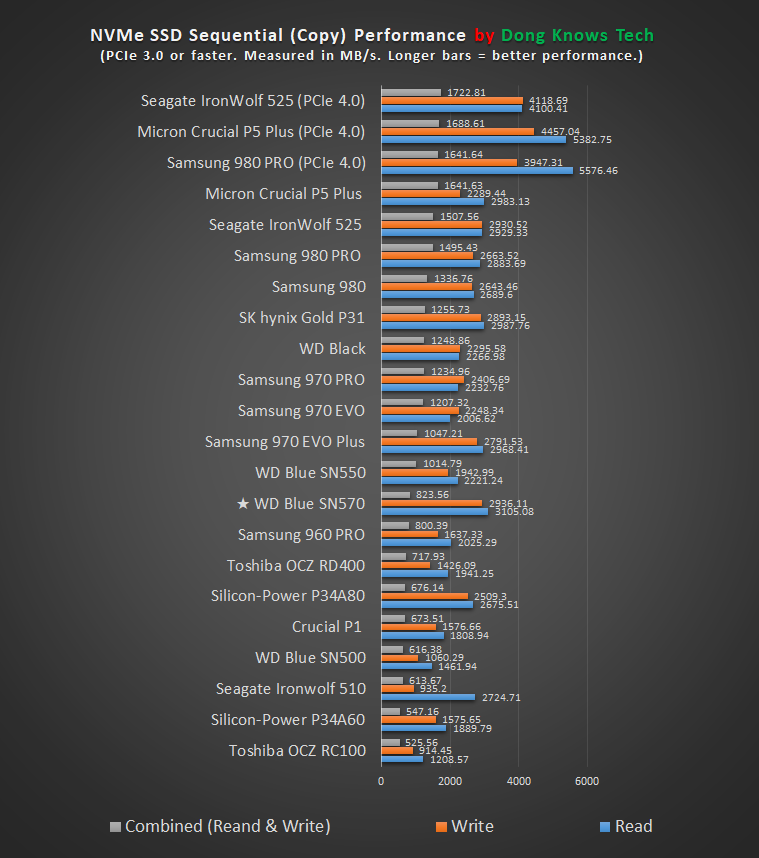The WD Blue SN570 NVMe SSD, first announced on October 4, brings both the price and performance of NVMe SSDs to a new low.
Indeed, the new drive’s performance reminds me of the Crucial P1—it’s more of a sprinter than a marathoner. On top of that, without the support for PCIe 4.0, the new SSD is not supposed to be an upgrade to the older WD Blue SN550.
But that a friendly cost of just $49.99, $59.99, and $109.99 for the 250GB, 500G, and 1TB capacities, respectively, it’s one of the most affordable NVMe SSD you can find. You can expect the street price to be even lower over time.
And even though the WD Blue SN570 doesn’t have much to brag about in performance among its NVMe peers, it’s still faster than most, if not all, SATA SSDs, let alone regular hard drives.
If you have a computer with an NVMe slot—most do these days—and want a replacement internal storage device, the SN570 is a good fit. Get one!
Dong’s note: I first published this post as a news piece on October 4, 2021, and last updated it on October 20 as an in-depth review after extensive hands-on testing.

WD Blue SN570: An affordable (and slow) alternative
Out of the box, the SN570 shares the blue color as the SN550. The new SSD has a standard form factor and is, therefore, has the same shape as all single-sided NVMe drives. It’ll work in any application where a 2280 drive is needed.
No PCIe 4.0, standard endurance
As the latest NVMe drive, the WD Blue SN570 disappointingly doesn’t support the new PCIe 4.0 standard, just PCIe 3.0 instead. It’ll work with the former, just at slower speeds.
Considering this is a modest drive in terms of performance—more in the performance section below—the PCIe 4.0 omission might be a good thing. It helps keep the cost down.
The SN570 shares one thing with most new PCIe 4.0-based SSDs, however: Endurance.
Indeed, the new drive has a rating of some 0.3 DWPD (drive written per day) and a five-year warranty. That means you can write up to a third of the drive’s total capacity per day and every day for five years.
If you want to put that in the total amount of data, it has the rating of 150TBW, 300TBW, and 600TBW for 250GB, 500GB, and 1TB, respectively. And those are the same as the PCIe 4.0 counterparts, including the Crucial P5 or the Samsung 980 PRO.
Considering WD calls the Blue as an SSD “built with creators in mind, providing fast speeds, data protection, and endurance to support their creative vision,” though, I was hoping that its endurance would be better.
But again, for the cost, the new SSD still has a lot of value.
Hardware specifications: WD Blue SN570 vs. WD Blue SN550
Western Digital is tight-lipped about the actual specs of its WD Blue SSDs. Instead, it only provides general information and what kind of performance and endurance you can expect from them.
| WD Blue SN570 | WD Blue SN550 | |
| Capacity / Part Number | 250GB / WDS250G3B0C 500GB / WDS500G3B0C 1TB / WDS100T3B0C | 250GB / WDS250G2B0C 500GB / WDS500G2B0C 1TB / WDS100T2B0C |
| Form Factors | M.2 2280 (80mm x 22mm x 2.38mm) | M.2 2280 (80mm x 22mm x 2.38mm) |
| Interface | PCIe Gen3 x4 NVMe v1.4 | PCIe Gen3 x4 NVMe v1.3 |
| Endurance (Terabytes Written) | 250GB: 150 TBW 500GB: 300TBW 1TB: 600TBW | 250GB: 150 TBW 500GB: 300TBW 1TB: 600TBW |
| Seq. Read (up to) | 3,500MB/s | 2,400 MB/s |
| Seq. Write (up to) | 250GB: 1200MB/s 500GB: 2300MB/s 1TB: 3000MB/s | 950 MB/s |
| Warranty | 5 Years | 5 Years |
| Release Date | October 4, 2021 | December 2019 |
| US Pricing (At launch) | 250GB: $49.99 500GB: $59.99 1TB: $109.99 | 250GB: $54.99 500GB: $64.99 1TB: $99.99 |
WD Blue SN570: Detail photos





Excellent Dashboard software, no features
The WD Blue SN570 comes with a downloadable Dashboard software that enables users to monitor the drive’s performance, life expectancy, upgrade its firmware, and more.
The software is intuitive and easy to use, akin to the Samsung Magician counterpart. Unfortunately, the drive itself has almost no user-accessible features.

Specifically, the new SSD has no over-provisioning or hardware encryption. There’s no way to turn up its performance via software either. In all, the Blue SN570 is a frill-free storage device.
WD Blue SN570: Modest (write) performance
Again, the WD Blue SN570 reminded me of the Crucial P1 in performance. It has a short bust of high-speed performance but, in extended tasks, proved to be the slowest NVMe SSD I’ve seen.

It’s worth noting, though, that this modest performance is only in the drive’s write speed. Its read speed is generally on par with other NVMe SSDs.
Specifically, in copy (sequential) tests, the drive can handle around 15GB of data with NVMe-grade speed—it’s fast. After that, it slows down to around 500MB/s—about the speed of a regular SATA SSD—and remains that way until the rest of the job.

On the chart above, note that the Read or Write tests use 10GB data, while the Combined test used 27GB. That’s the reason why the latter was much slower.
The “sprinter” effect was more acute in random access where the drive needs to perform both read and write constantly. Here, the WD Blue SN570 proved to be the slowest NVMe SSD I’ve seen in heavy tasks.

In a lighter random access test, it did better, however.
I also used the WD Blue SN570 in daily tasks for anecdotal testing, and the real-world experience was generally similar to other drives.
However, when I needed to copy a lot of data or use resource-intensive applications, such as Photoshop, to consolidate an extensive database, it was clear that this SSD wasn’t the ideal choice.
WD Blue SN570's Rating

Pros
Fast (read) performance for casual computing
Affordable
Excellent Dashboard software
5-year warranty
Cons
Low random access performance and slow write copy speed in extended tasks
No security or user-accessible overprovisioning features
Capacities cap at just 1TB
Conclusion
In many ways, the WD Blue SN570 represents an affordable NVMe SSD option. If you’re looking to upgrade an entry-level computer for daily tasks, it’s a great buy.
But if you want something that can deliver the best performance, get another NVMe option instead. For intensive tasks, even the WD Blue SN550 is better.



Hi, will kingston kc2500 better choice if price is similar.
Since kc2500 with dram design.
I haven’t tested the Kingston, C. But generally DRAM alone doesn’t mean much.